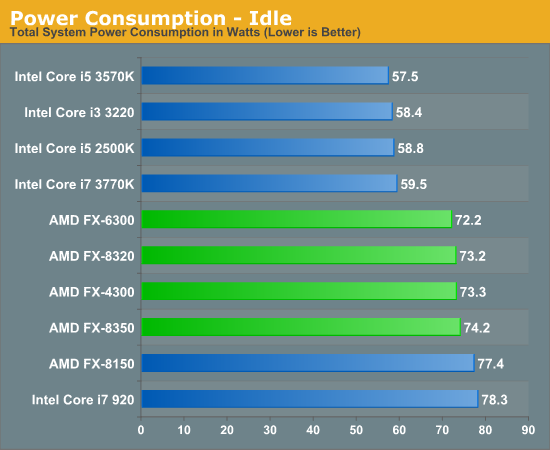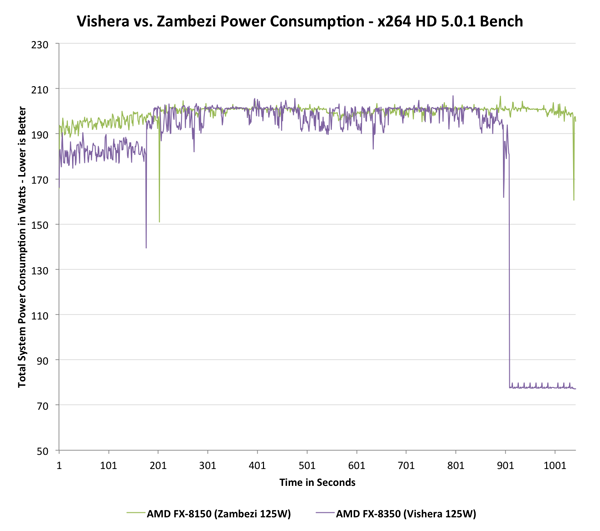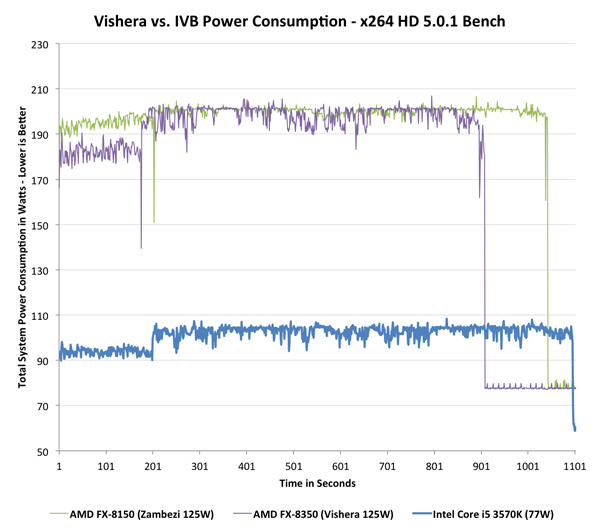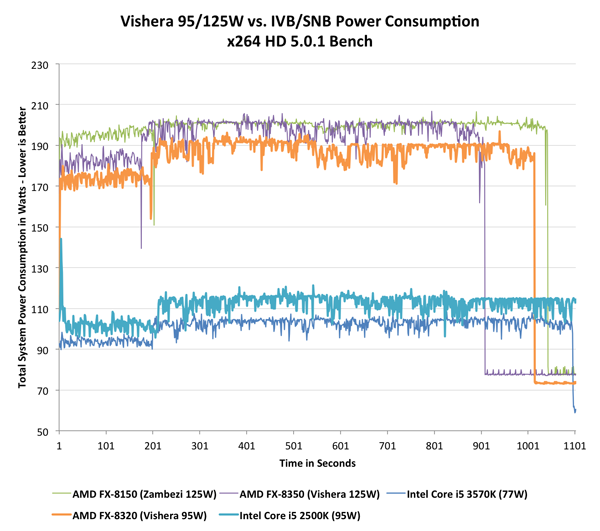The Vishera Review: AMD FX-8350, FX-8320, FX-6300 and FX-4300 Tested
by Anand Lal Shimpi on October 23, 2012 12:00 AM ESTPower Consumption
With Vishera, AMD was in a difficult position: it had to drive performance up without blowing through its 125W TDP. As the Piledriver cores were designed to do just that, Vishera benefitted. Remember that Piledriver was predominantly built to take this new architecture into mobile. I went through the details of what makes Piledriver different from its predecessor (Bulldozer) but at as far as power consumption is concerned, AMD moved to a different type of flip-flop in Piledriver that increased complexity on the design/timing end but decreased active power considerably. Basically, it made more work for AMD but resulted in a more power efficient chip without moving to a dramatically different architecture or new process node.
In mobile, AMD used these power saving gains to put Piledriver in mobile APUs, a place where Bulldozer never went. We saw this with Trinity, and surprisingly enough it managed to outperform the previous Llano generation APUs while improving battery life. On desktops however, AMD used the power savings offered by Piledriver to drive clock speeds up, thus increasing performance, without increasing power consumption. Since peak power didn't go up, overall power efficiency actually improves with Vishera over Zambezi. The chart below illustrates total system power consumption while running both passes of the x264 HD (5.0.1) benchmark to illustrate my point:
In the first pass Vishera actually draws a little less power, but once we get to the heavier second encode pass the two curves are mostly indistinguishable (Vishera still drops below Zambezi regularly). Vishera uses its extra frequency and IPC tweaks to complete the task sooner, and drive down to idle power levels, thus saving energy overall. The picture doesn't look as good though if we toss Ivy Bridge into the mix. Intel's 77W Core i5 3570K is targeted by AMD as the FX-8350's natural competitor. The 8350 is priced lower and actually outperforms the 3570K in this test, but it draws significantly more power:
The platforms aren't entirely comparable, but Intel maintains a huge power advantage over AMD. With the move to 22nm, Intel dropped power consumption over an already more power efficient Sandy Bridge CPU at 32nm. While Intel drove power consumption lower, AMD kept it constant and drove performance higher. Even if we look at the FX-8320 and toss Sandy Bridge into the mix, the situation doesn't change dramatically:
Sandy Bridge obviously consumes more than Ivy Bridge, but the gap between a Vishera and any of the two Intel platforms is significant. As I mentioned earlier however, this particular test runs quicker on Vishera however the test would have to be much longer in order to really give AMD the overall efficiency advantage.
If we look at average power over the course of the two x264 encode passes, the results back up what we've seen above:

As more client PCs move towards smaller form factors, power consumption may become just as important as the single threaded performance gap. For those building in large cases this shouldn't be a problem, but for small form factor systems you'll want to go Ivy Bridge.
Note that idle power consumption can be competitive, but will obviously vary depending on the motherboard used (the Crosshair Formula V is hardly the lowest power AM3+ board available):














250 Comments
View All Comments
Operandi - Tuesday, October 23, 2012 - link
Looks like Piledriver delivered. Granted the bar was set pretty low with Bulldozer but this at least has a use case, highly threaded applications but considering this is a process node behind Intel I’d say its pretty good. If they can keep this pace up and hit IPC a bit harder AMD could be back in a pretty good position.silverblue - Tuesday, October 23, 2012 - link
At least now they can say they beat Intel in a lot of multithreaded situations. Losing to Intel AND using more power was unpalatable. I'd like to see an undervolted 8350, perhaps AMD's conservative side is rearing its ugly head again.I'm a bit concerned that, even with hard-edge flops and the RCM, the clock speed difference is about 11% for the same power. I'd have thought that even the former would shave off a decent amount, unless RCM doesn't work so well at higher speeds. Still, there's one disadvantage to be had - overclocking won't work so well due to the flop change.
If AMD can beat Intel now in multithreading in most circumstances, Steamroller is just going to let them pull away. Single-threaded workloads are the worry, though. Still, at least they can say that they finally beat Nehalem even in single-threaded work. I did lament the lack of an appearance of Phenom II, but looking at the results, they've buried that particular ghost.
Finally - Tuesday, October 23, 2012 - link
Undervolting, you said?Here you go: http://www.computerbase.de/artikel/prozessoren/201...
Spunjji - Tuesday, October 23, 2012 - link
Thanks! +1 to that.CeriseCogburn - Tuesday, October 30, 2012 - link
ROFL, thank you the 3 stooges.I'd like to particularly thank silverblue the little co amd fanboy who provided immense entertainment in that they lost, then moments later, they won, deranged fantasy spew. Good to know Stearoller is going to "pull away" !
hahahahhahahahahha
One for all and amd all won !
LOL
rkrb79 - Friday, October 10, 2014 - link
FYI I joined Anandtech just so I could tell you that you are a douchebag!!Taft12 - Tuesday, October 23, 2012 - link
+2 in fact!An official lower-TDP version version of the 8-core CPU would be very nice. 95W or even lower as Intel does with their -S SKUs.
At my workplace, the i7-3770S has been just plain outstanding for our small form-factor server/workstation appliance that travels to tradeshows with our sales guys. I'd happily trial an AMD 8-core equivalent.
silverblue - Wednesday, October 24, 2012 - link
Happy to +3 you on that. :)CeriseCogburn - Tuesday, October 30, 2012 - link
- 10 for the once again PATHETIC HACKING that is required for amd to be acceptable.(that's minus ten !)
LOL - fan boy fan joy fan toy EPIC FAIL !
StevoLincolnite - Tuesday, October 23, 2012 - link
I wouldn't say it has delivered. Not yet anyway.Remember the Phenom 2's IPC is lower than the later model Core 2's and Piledriver still needs 700mhz+ to beat a Phenom 2, so that puts it in perspective.
Mind you, overclock the NB on a Phenom 2 and you can get some pretty interesting gains in the range of 5-15% depending on the situation.
However, like AMD has done for the last several years, they are happy to throw more cores at the performance problem, which is great, we just wish those cores were a little beefier or software to become more heavily threaded.
The other flip-side is this will drop straight into some AM3 motherboards and all AM3+ motherboards, so it's a worthy upgrade if you're running something like an Athlon, plus it's cheap.
But the consensus is that if you're still running a Phenom 2 x6, and you don't need 8-threads and mostly play video games, it really is throwing money into the fire in order to upgrade to the FX line, Piledriver or not, unless you intend to overclock the chips to 4.8ghz+ which the Phenom 2's can't reach on air.